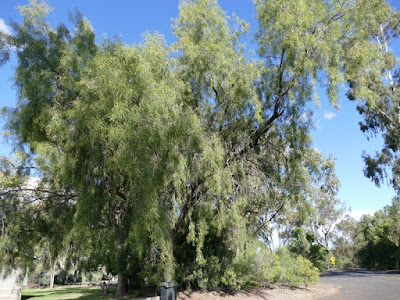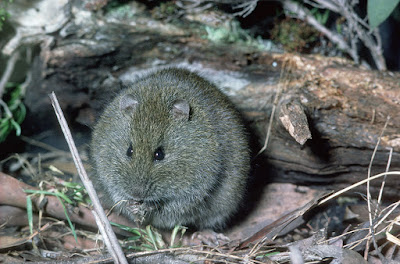It's been a while since I posted another in my sporadic series of favourite botanic gardens, so I thought I'd compensate today with two for the price of one, both of which I visited (one for the first time) on my recent trip to tropical Queensland. Both these were visited on the trips up and back - Emerald is within the tropics by only about 15km, Goondiwindi ('gun-da-WINdy') much further south, though still sub-tropical. Both have average rainfalls between 600 and 650mm a year, with most falling in summer (more pronounced for Emerald). Both are only around 200 metres above sea level and can get very hot in summer. Despite these apparent similarities however their respective botanic gardens, which both had their genesis in the late 1980s - and are both delightful in their own ways - are very different indeed.
 |
| Emerald is (naturally) at the end of the green arrow, Goondiwindi is indicated by the red one. |
Perhaps appropriately, the Emerald gardens are much greener; on the shores of the Nogoa river (which flows, via the Fitzroy River, east into the Pacific) I assume the river is used to irrigate them. The town name, incidentally, comes from the name of the cattle station on which it was built, which of course explains nothing at all.
 |
| Some of the central shady lawns, well used by visitors and locals (the latter including many birds). |
The gardens opened in 1987 - though I don't have any details on the history of their development - and are managed by the local council.
I have no doubt that this oasis in a busy mining-oriented town has lots of wildlife, but I was only there fairly briefly during the afternoon and saw mostly common species. Still, no reason not to celebrate them too.
 |
| Laughing Kookaburra Dacelo novaeguineae, utilising the facilities. |
 |
| Rainbow Lorikeets Trichoglossus moluccanus attracted by scattered seed. Not such a great idea, as they are very pugnacious and will drive other birds off, but they really are gorgeously coloured. |
 |
| Yellow-throated Miners Manorina flavigula are aggressive, colonial inland dwellers. |
 |
| Blue-faced Honeyeater Entomyzon cyanotis, a striking big honeyeater of the inland east and the tropics. This is a young bird without a strongly blue face. |
The Goondiwindi gardens are very different in intent and their appearance is accordingly also very different; their formal name, Botanic Gardens of the Western Woodlands, reflects this. Their 22 hectares were gazetted in 1987, following determined action by a committee of local field naturalists to turn a newly excavated area of degraded woodland to good use. They were supported by the local council who acted as a trustee and later by a federal Bicentennial grant in 1988 and by private donations.
 |
| Welcome to the gardens, on the northern edge of town. |
Plantings began in 1988 of thousands of trees and shrubs across the site but I can't determine when the gardens opened to the public. The key difference between this garden and Emerald's is that the Goondiwindi committee determined from the start that the focus was to be exclusively on the plants of the upper Darling catchment; the plantings represent species of 27 plant communities within this semi-arid area. (The Darling is one of the two major rivers of the mighty Murray-Darling Basin which dominates south-eastern Australia, flowing to the sea on the south coast.)
As with Emerald, there are lawns and covered areas (including the concert stand below) to serve the community, in addition to the magnificent plantings.
 | |
| Queensland Bottle Tree Brachychiton rupestris. Labelling is generally excellent. |
 |
| Weeping Myall Acacia pendula; a very elegant wattle of the western plains. |
 |
| River Cooba Acacia salcina, a wattle mostly associated with watercourses. |
 |
| Senna sp.; there are many species, and within some species a bewildering array of sub-species with different leaf forms. I don't blame them for not labelling this one, and I can't help! |
 |
| An Eremophila garden is always of interest to me; the signage is broadly informative, well beyond just identifying plants. |
 |
| Scaly-breasted Lorikeet Trichoglossus chlorolepidotus, a smaller and relatively demure relation of the raucous and pushy Rainbows (see above), feeding on eucalyptus blossom. |
If you're passing through either of these towns - and many people do - please make the time to visit their gardens. You won't be disappointed.
(Any hints for gardens, especially native ones, that I should visit would be gratefully received.)
BACK ON THURSDAY

















































